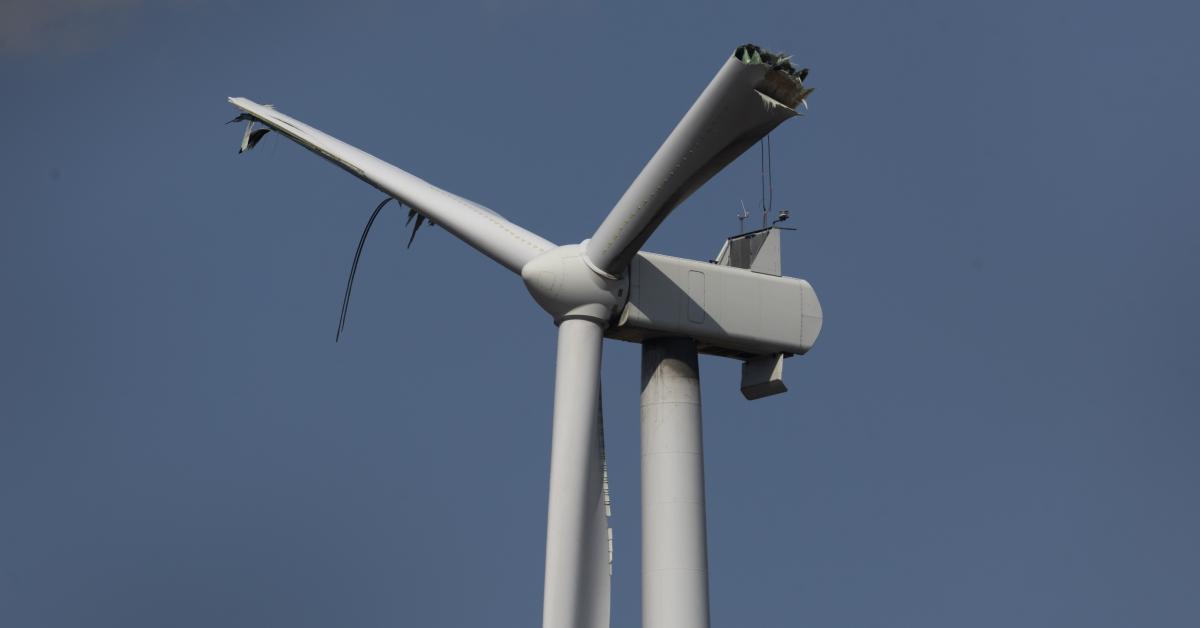We support our Publishers and Content Creators. You can view this story on their website by CLICKING HERE.

The company that manufactured a blade that broke free from a wind turbine off the coast of Nantucket in July is facing lawsuits and allegations that its quality control data was altered.
GE Vernova, the company that manufactured the blade, reported in its third quarter earnings call that the blade incident will cost the company $700 million. The failure scattered debris across the beaches of Nantucket, and as far away as New York and Rhode Island.
The company dispatched two vessels in October to retrieve what remained of the 300-foot blade from the bottom of the ocean, and the company was supposed to have finished the operation by the end of the month. Four months after the blade broke, according to Nantucket resident Mary Chalke, debris continues to wash up on the shores of the island.
“They’re small pieces. They seem to be getting smaller and smaller,” Chalke said in a video posted on X on Monday, which shows pieces of the blade about the size of a pencil eraser in the sand.
On Friday, Chalke posted another video of the foam pieces along with other debris she’s collected. She said there isn’t any information publicly available on how much of the broken blade has been recovered and how much remains in the water.
Allegations
GE Vernova has long blamed a “manufacturing deviation” resulting in “insufficient bonding,” at the company’s manufacturing facility in Gaspé, Canada. Radio Gaspésie, a local media outlet, reported in October, citing unnamed sources, that senior executives had asked employees to falsify data. Reuters reported Thursday, also citing unnamed sources, that the company had fired several workers after an investigation revealed they had taken shortcuts on quality control.
The New Bedford Light reported that at least 14 turbine blades GE Vernova manufactured for the Vineyard Wind project have been shipped to France. The company laid off nine managers and suspended 11 unionized floor workers at the Gaspé facility, according to the Light. A spokesperson for the union told the Light it’s contesting the suspensions of the floor workers, who it says shouldn’t be held responsible for the “directives of their former supervisors.”
Vineyard Wind and the Bureau of Safety and Environmental Enforcement have not commented on the allegations. Just the News reached out to GE Vernova for comments, but did not receive a response.
Elmer “Bud” Peter Danenberger, an engineer who spent 38 years in the Interior Department’s offshore oil and gas program, noted on his “Bud’s Offshore Energy” blog that if the allegations are true, the actions could be in violation of federal law.
GE Vernova also manufactured two blades that failed at the Dogger Bank Wind Farm, off the coast of England, which the company blamed on improper installation.
Scott Strazik, CEO of GE Vernova, told The Financial Times that the company was holding off on offshore turbine orders while it waits for market conditions to improve. The company has a $3 billion backlog of offshore orders that will take two years to complete, Strazik said, which are much more complicated than onshore projects.
Trouble ashore
According to a lawsuit filed by the Public Service Company of Oklahoma and Southwestern Electric Power Company, GE Vernova’s onshore business also has defective product issues. The lawsuit names as the defendant GE Renewables North America, which is part of GE Vernova, and says that GE supplied wind turbine generators for three wind farms in Oklahoma.
“Within only two to three years of commercial operation, the GE wind turbine generators have exhibited numerous material defects on major components and experienced several complete failures, at least one blade liberation event, and other deficiencies,” the complaint states.
The blade “liberation” originated from a crack on the leading edge of the blade, according to the lawsuit. The plaintiffs identified cracks on other blades, as well as delamination, which can result in blade failures.
“The same problems GEV is having with Vineyard Wind’s turbine blades are also happening in its onshore turbines. Therefore, the disastrous blade failure that happened offshore Nantucket in July will almost certainly occur again with perhaps even worse results.,” energy expert Robert Bryce, who originally posted the lawsuit, wrote on his Substack.
Losing support
The blade failure at Vineyard Wind rippled across the entire offshore wind industry. The Barr Foundation published a survey in July of 400 Rhode Island voters, which found that 70% wanted more of their electricity to come from offshore wind. This survey was done shortly before the Vineyard Wind blade failure. The Rhode Island Current reported that a September poll of 800 likely voters found that only 58% of them want more energy from offshore wind.
While it’s not clear the blade failure had anything to do with the decline in support, a ballot question asking voters in Cape Cod to support a nonbinding endorsement of offshore wind development failed 52% to 48%.
The Nantucket Current reported on Nov. 7 that 155 businesses on the island are urging local officials to withdraw from a “Good Neighbor Agreement.” The agreement was signed in 2020 by Nantucket, the Nantucket Preservation Trust and the Maria Mitchell Association. In exchange for supporting the Vineyard Wind project, the developer provided $16 million to mitigate historical, cultural and economic impacts.
The Maria Mitchell Association, an educational astronomy nonprofit on Nantucket, withdrew from the agreement at the end of October. “For the past several years, as more information became available regarding additional wind turbine projects, the aggregate impact of the lighting from each turbine, and the recent blade failure, it became increasingly clear to us that the impact on our night skies and our island community was not something we could support,” the organization explained in a statement on its website.
President Joe Biden committed the U.S. to building 30 gigawatts of offshore wind power by 2030, but President-elect Donald Trump has vowed to end the industry. With the industry struggling to stay afloat, it’s in for some rough seas without taxpayer support.
Meanwhile, residents of Nantucket, like Chalke, continue to clean up pieces of blade from their beaches.
“They [GE Vernova] seem to be allowed to regulate themselves and to monitor themselves. We’re putting our safety, human health, and the safety of our marine life, and our tourism, and our beaches in their hands,” Chalke said in her video posted on Monday.

 Conservative
Conservative  Search
Search Trending
Trending Current News
Current News 





